Coming up with bass lines is difficult if you don`t know where to begin. Thus, learning some easy bass patterns is a good idea, as these will give you a helpful starting point.
These are sets of notes on the fretboard of the bass that can be played in different ways. By using them, you ensure that your lines are always in the right key and sound cohesive and harmonious.
Below you will 9 bass patterns with tabs, notation, and a fretboard image. I have also included some ideas and examples of how each of them can be used, and how to change the key of them if needed.
I`m going to start with some basic patterns that every bassist should know. Then, I`ll show you some personal favorites of mine that will elevate your playing, while still being beginner-friendly to play.
1. Core Notes & Minor 7th
Our first pattern consists of just 4 notes and is a great place to start for a range of reasons. The large steps in it give it a groovy sense of movement, it`s easy to play and memorize, and it can be used in any genre under the sun.
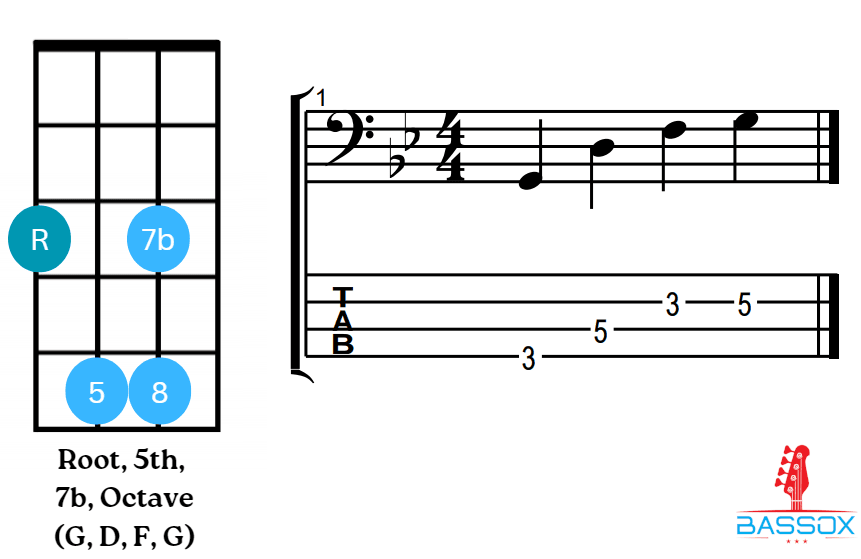
It`s a very forgiving and beginner-friendly pattern as you can do almost anything you want with it. All of the notes lead naturally into one another. In particular, the 5th and 7th resolve naturally back into both the deep root note and the high octave.
For an example of this pattern in a song, listen to Bill Wyman`s line on Miss You by the Rolling Stones.
To simplify the pattern, you can cut out the minor 7th and merely use the root, fifth and octave. Chris Wolstenholme`s bass line on Muse`s Plug in Baby is an excellent example. Here, he uses the pattern to play a hard-hitting and funky groove, all with just 3 notes.
Variation: This pattern is in a minor key. To play it in a major key, play the 7th a half-step higher. Alternatively, the pattern works great in both keys when not playing the 7th at all.
2. Major Scale Pattern
To accentuate the feel of a key signature, there are certain notes are more potent than others.
In the major and minor scales, the root, 2nd, 4th, and 5th are the same. The 3rd, 6th, and 7th are the steps that set the scales apart and give them their distinct characteristics.
However, relying solely on the 3rd 6th, and 7th can make it hard to play cohesive and harmonious lines. Thus, this pattern aims for a healthy mix.
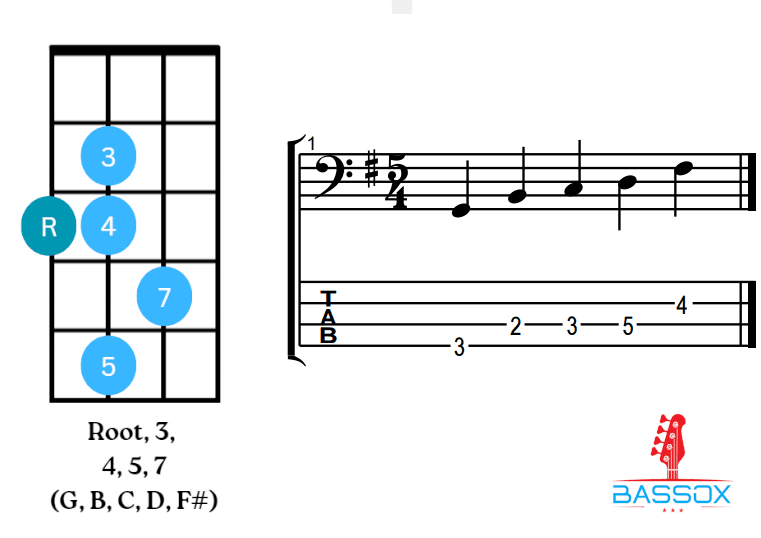
It includes the perfect 4th and 5th which it shares with the minor scale. It also includes the major 3rd and major 7th, which gives this pattern an upbeat and cheerful feel.
As a result, there are many ways to use the pattern to play jovial and upbeat bass lines. You can play it up and down, groove on the root note while immediately moving to other notes, or play arpeggios.
The 3rd and 7th will be effective both when using them to lead into the 4th and 5th, or by grooving on them for extended periods. What`s important is that you don`t solely rely on the root, 4th, and 5th, as this will result in the pattern sounding like it lacks a clear major-scale character.
Variation: The pattern can be played in a minor scale by playing the 3rd and 7th a half step deeper. This will make it sound more somber, especially when accentuating the minor 3rd. It will however not accentuate the minor scale to the same level as pattern #3.
3. Minor Scale Pattern
This third bass pattern is simple, as it consists of the first 6 notes of the minor scale. It is also incredibly effective for playing melancholy and melodic grooves.
Just like the major scale pattern above, it makes use of distinct minor-scale steps to give the pattern a unique feel. Instead of the 3rd and the 7th, this one uses the 3rd and 6th. This is because I find the 6th to work better than the 7th to write beautiful minor-sounding melodies.
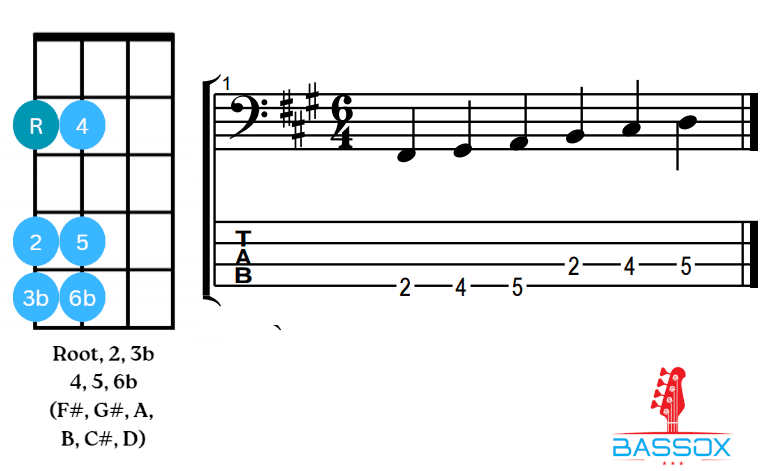
Personally, I find myself reverting back to this pattern quite often. By now, I`ve come up with hundreds of riffs without thinking about what key I was playing. When this happens, it`s a common occurrence that I have used the above pattern unconsciously.
In particular, by switching between the 5th, minor 6th, and minor 3rd, you are likely to come up with some great melodies. I find these notes to have a particularly sorrowful character when used together, with the 4th and 2nd serving as great supplementary notes.
Examples include Feel Good Inc by Gorillaz and Christa Hillhouse`s bass line on What`s Up? by 4 Non-Blondes.
Variation: You can play this pattern in a major key by playing the 3rd and 6th a half step higher. This makes the tone of it more upbeat and hopeful but does not accentuate the major scale to the same degree as pattern #2.
4. Basic walking bass groove
Most bass patterns can be used to play a walking bass line. However, there are some patterns that lend themselves especially well to walking.
In particular, it is common for walking patterns to include a tritone which leads up to the perfect 5th, or down to a perfect 4th. This note gives the walking lines their characteristic jazzy feel while providing just the right amount of tension.
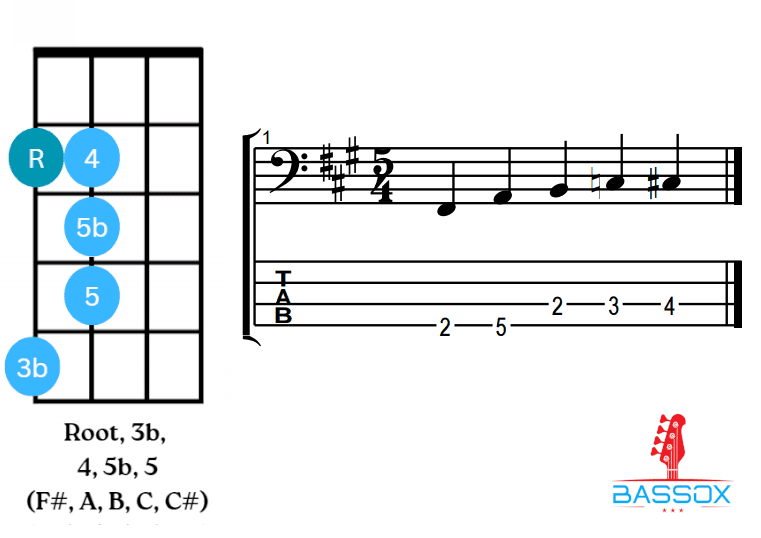
This pattern can be played up and down at a quarter-note pace for a basic walking bass line. If you want to add more spice to it, you can also play it with an 8th-note triplet feel. For a more in-depth explanation of these techniques check out my list of walking bass exercises.
You will also find this pattern in non-walking lines. Examples of this include Duff McKagan`s groove on Guns N` Roses` Knockin` On Heavens Door and Kim Deals’ bass line on Hey by the Pixies.
Variation: The above pattern is played in a minor key. To play it in a major key instead, simply play the 3rd a half-step higher.
5. 2nd & 7th Groove
I`m including this pattern because it has a shape that is easy to remember while still being great for writing melodic bass lines. It consists of our old friends the 4th and 5th, as well as a major 2nd and minor 7th.
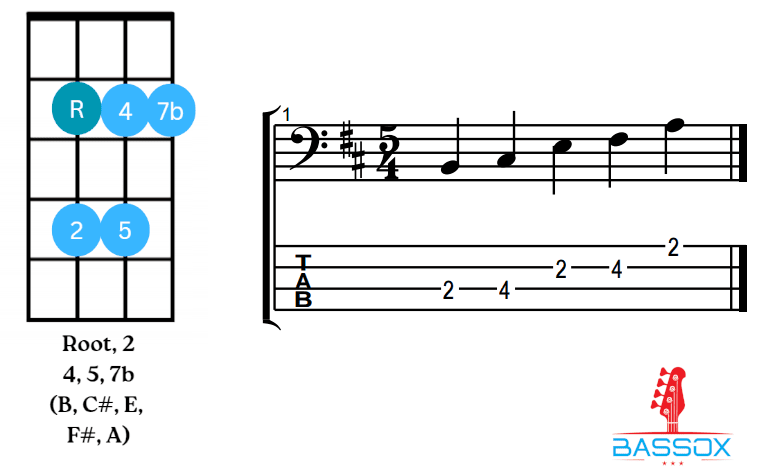
Despite its name, the major 2nd is part of both the major and minor scale. As this pattern also has a minor 7th this is thus a minor scale pattern.
However, due to the major 2nd being part of both scales, this pattern has less of a minor or major feel than patterns #2 and #3. Instead, it allows you to focus on the groove and come up with some funky rhythms rather than emphasizing the key of a song.
Despite being similar to pattern #1, the major 2nd gives this pattern a distinct feel. This is because the note gives you more ways to play deep groves, which makes it more impactful when you move up to the 7th or octave.
Variation: You can play the minor 7th a half step higher to play this pattern in a major key. Alternatively, you can elect to not play the 7th at all and have this pattern be applicable in both scales.
6. Deep 7th Minor Groove
This pattern introduces a note that is played below the root note.
Deeper notes of this kind can work wonders, as they often lead more naturally back to the root note than notes that are played higher than it. Deep notes of this kind are also great for making your lines sound more dynamic and lively.
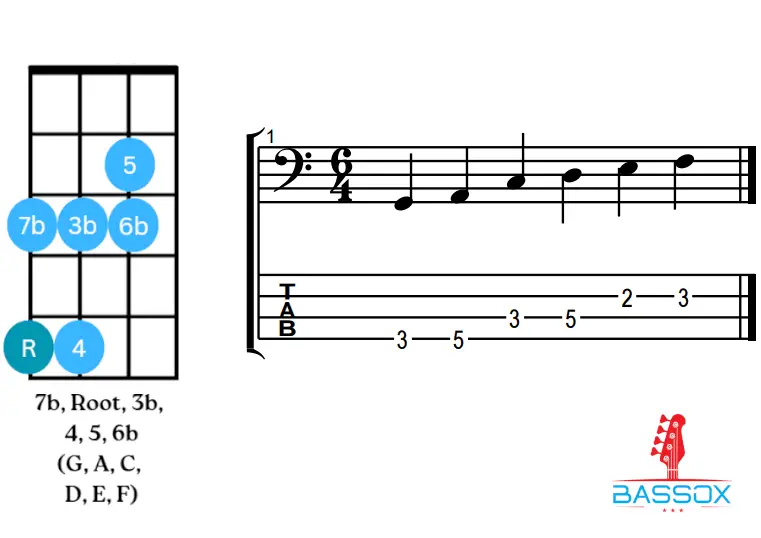
It resembles pattern #2 but removes the major 2nd in favor of a low minor 7th. Thus, this is a minor scale pattern that more strongly emphasizes the root note.
You will notice this if you play a groove that ends on the deep minor 7th followed by a root note. This creates a different sense of resolution than if you descended to the root note, which works incredibly well for bass lines.
Furthermore, the minor 7th to root movement has an adventurous and fairytale-like character to it. As a result, you will find this movement in lots of video game soundtracks, such as the track Legendary Hero from Legend of Zelda: The Wind Waker.
For us bass players, this is thus a great pattern for both writing beautiful melodies and heavy grooves that emphasize the first beat of a bar.
Variation: To play this bass pattern in a major key, play the 3rd, 6th, and 7th a half-step higher. Using deep notes of this kind is effective in creating smooth transitions in major keys. However, I find the minor 7th to sound particularly beautiful for moving up to the root note, which is why I`ve written it out in a minor scale.
7. Major 6th Groove
I love this major 6th pattern as it is so easy, but also so effective.
It consists of a major triad, meaning the root, third, and fifth of a major chord. All that`s added is a high major 6th above the 5th and a low major 6th below the root note.
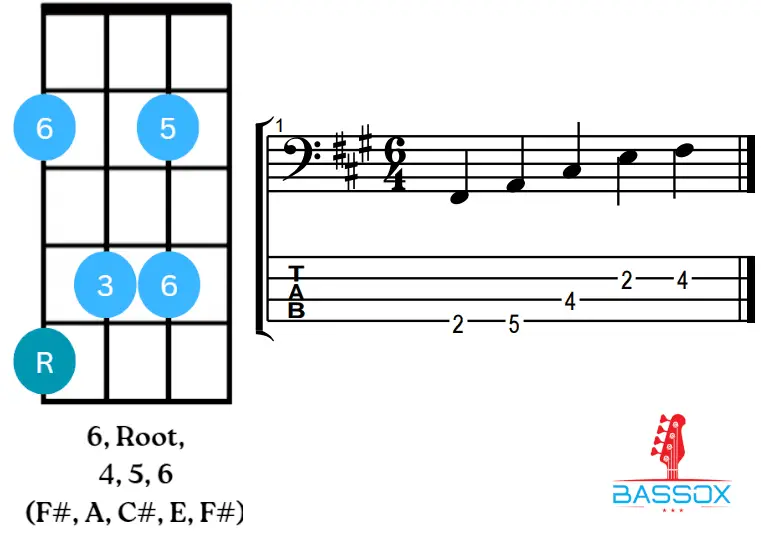
Similar to pattern #2, this is thus great for attaining a major scale feel, with the help of the major 3rd. I`ve always found the 6th to have somewhat of a hopeful and unique character to it that differs from the 7th.
As a result, this pattern has an optimistic feel to it. Especially so because of the deep major 6th which leads beautifully back to the root note.
When returning to the root note from below, it is common to use the 7th step of the scale. However, the 6th also works well for this purpose and works great when played as the last note of a melody before returning to the root note.
This pattern is thus great to add some spice to your line when playing in a major key. I also find it fitting for songs that are not just positive but also have a deeper sentiment of yearning and hope.
Variation: The pattern can be adapted to a minor scale by playing both 6ths and the 3rd a half-step deeper. Similar to pattern #3, this can make for some beautiful melodies. However, the low minor 6th won`t have the same sense of resolution, as the 7th in pattern #6.
8. Deep 5th and minor 7th
This bass pattern further emphasizes the use of deep notes below the root note. This time around, there are fewer notes to be played above it, and there is an added 5th below it.
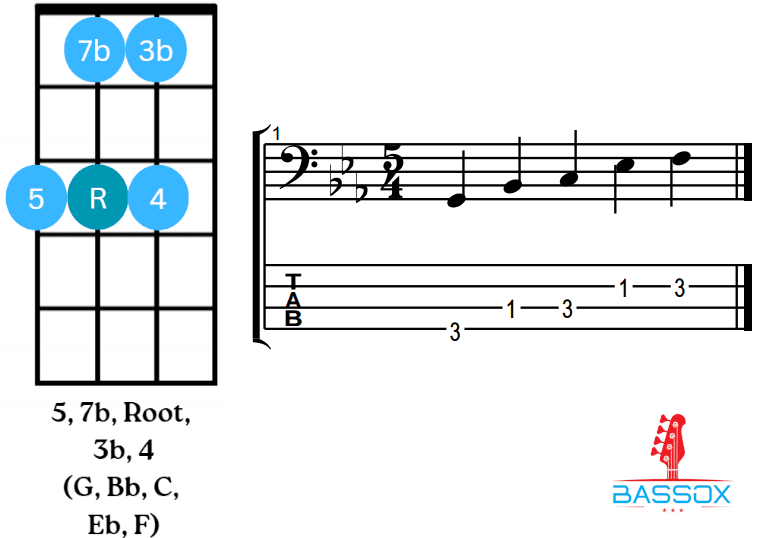
In my 16 years of playing the bass, the deep 5th has to be one of my most used notes. It has the double effect of both leading comfortably back to the root note and being great for writing grooves that constantly switch between the two.
It also includes the minor 7th for its effects described in pattern #6 and the minor 3rd for the effect of pattern #3. The result is a versatile 5-note pattern that you can get creative with, and that can truly elevate a song when used right.
For an example of how to use it, check out Ben Kenney`s work line on Anna Molly by Incubus.
Variation: To play this pattern in a major key, play the minor 3rd and minor 7th a half-step higher. This makes for a pattern that has many of the same benefits while emphasizing the major scale instead.
9. Dominant chord pattern
I want to end on a dominant chord bass pattern.
This is not because the shape of it is any more difficult than any of the other entries; it isn`t. What it shows us is that bass patterns can be used in different contexts, depending on what chord it is being played over.
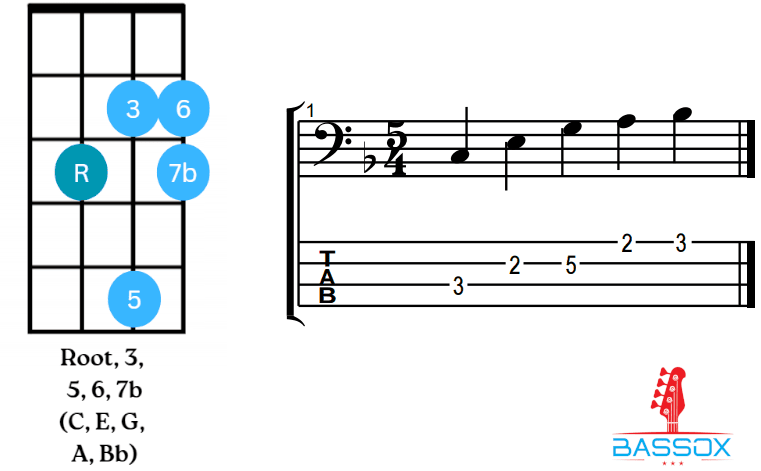
This pattern has both a major 3rd and a minor 7th. Thus, it does not clearly belong in either key and would sound disharmonic if you tried to play it over a major or minor chord willy-nilly.
As the name of it suggest though, it does fit under dominant chords. “Dominant” is another word for the perfect 5h of a scale. The pattern will thus fit under certain chords that make use of the perfect 5th.
Examples of this include the “V” (5th) chord of the major scale and the “Vii” (7th) chord of the minor scale. Played over these chords, the above pattern sounds perfectly harmonious and works wonders.
Depending on your knowledge of music theory, this might sound confusing or completely obvious. My point is this though, all bass patterns can be used in multiple ways and can even be combined.
If the song calls for it, you can start with pattern #3, switch to pattern #9 during a dominant chord, and then pattern #6 for some added variation. You can do this during a groove that keeps repeating itself, or between different parts of a song.
With that, learning these patterns and experimenting with them will give you the tools needed to improvise, write and jam as a bass player.
When you become comfortable with this, you will start to unlock new tools by discovering how these patterns relate to one another and how they can be used together.

